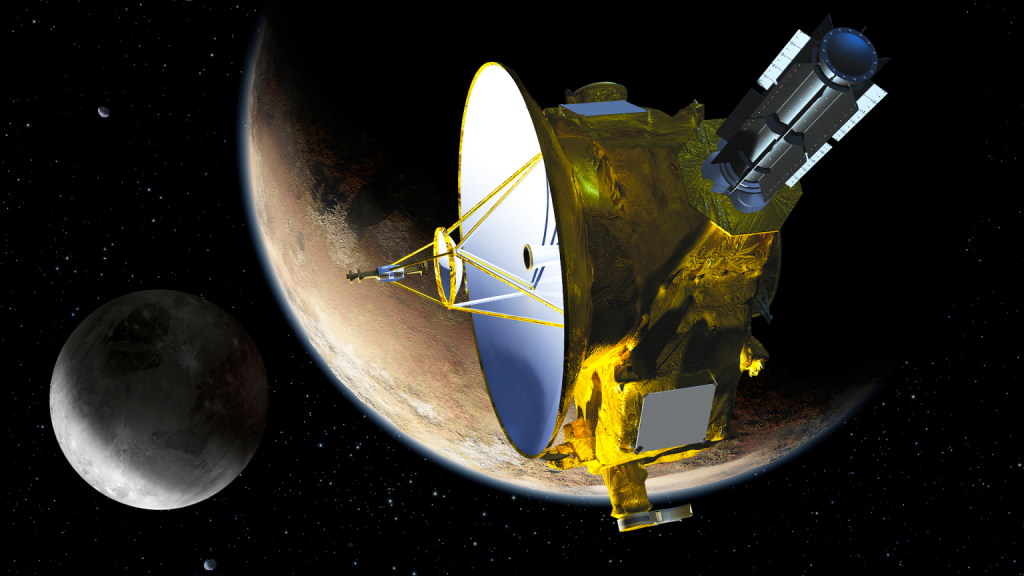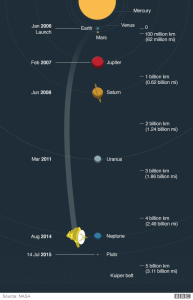New Horizons Mission to Pluto: The Complete Story of NASA’s Historic Journey

The New Horizons Mission to Pluto stands as one of the most remarkable achievements in the history of space exploration.
For decades, Pluto remained a blurry dot in telescopic images, its true nature a cosmic mystery. Everything changed on July 14, 2015, when NASA’s
New Horizons spacecraft completed the first-ever flyby of Pluto, capturing breathtaking images and collecting invaluable scientific data.
This mission transformed our understanding of the dwarf planet, its moons, and the distant Kuiper Belt.
Introduction: Why the New Horizons Mission to Pluto Matters
When the New Horizons Mission to Pluto launched in 2006, humanity had never seen Pluto up close.
What little we knew came from telescopic observations, fuzzy images, and indirect measurements. The mission was designed to answer the questions that scientists, students, and space enthusiasts had been asking for generations: What does Pluto really look like? Does it have an atmosphere? Are there geological processes happening so far from the Sun?
New Horizons shattered expectations by revealing a complex, dynamic world full of mountains made of water ice, a heart-shaped glacier,} a hazy atmosphere, and evidence of cryovolcanism. It also provided detailed data on Pluto’s moons—especially Charon—and pushed deeper into the Kuiper Belt to explore ancient planetary building blocks.
Origins of the New Horizons Mission
The concept for a mission to Pluto began decades before it finally lifted off. Throughout the 1990s and early 2000s, a series of proposals—Pluto Fast Flyby, Pluto-Kuiper Express, and others—fell victim to budget challenges and political debates.
Eventually, NASA selected New Horizons as part of the "New Frontiers" program, a mid-cost initiative designed to tackle high-value planetary science objectives. Under the leadership of Dr. Alan Stern, New Horizons moved from proposal to reality, launching on January 19, 2006, aboard an Atlas V rocket.
Just seven months after launch, the spacecraft performed a gravity-assist flyby of Jupiter, gaining the speed it needed to reach Pluto in record time.
Scientific Objectives of New Horizons
The New Horizons Mission to Pluto was built around several major scientific goals:
1. Map Pluto’s Surface
Create the first detailed global maps of Pluto's geology, terrain, and color variations. Prior to New Horizons, Pluto’s surface
features were completely unknown.
2. Study Pluto’s Atmosphere
Measure atmospheric composition, temperature, haze layers, escape rates, and seasonal behavior. New Horizons carried instruments
specifically designed for atmospheric analysis.
3. Explore Charon and Other Moons
Study their orbits, geology, surface composition, and interactions with Pluto.
4. Understand Pluto’s Interior & Composition
Determine whether Pluto has a subsurface ocean, measure density and structure, and analyze its surface ices.
5. Explore Kuiper Belt Objects
After Pluto, New Horizons continued deeper into the Kuiper Belt to investigate objects that preserve ancient materials from the early Solar System.
Spacecraft Design & Engineering
New Horizons was engineered to operate more than 3 billion miles from Earth, where sunlight is 1/1,000th as strong as it is near our planet.
Its instruments needed to be extremely sensitive, lightweight, and energy-efficient.
Key components include:
- LORRI (Long Range Reconnaissance Imager) — captured the sharpest images of Pluto.
- Ralph — produced color maps and infrared spectra of Pluto’s surface.
- Alice — analyzed atmospheric composition via ultraviolet spectroscopy.
- REX — studied temperature, pressure, and atmospheric structure.
- SWAP & PEPSSI — measured solar wind interactions and energetic particles.
New Horizons travels through space using a plutonium-powered RTG (radioisotope thermoelectric generator), essential for operations
in the dim environment beyond Neptune.
Journey to Pluto: A Timeline of Key Milestones
The New Horizons Mission to Pluto followed this historic timeline:
- January 19, 2006: Launch from Cape Canaveral.
- February 2007: Jupiter flyby for gravity assist.
- 2007–2014: Cruise phase; spacecraft enters hibernation cycles.
- December 6, 2014: Mission officially begins Pluto approach.
- July 14, 2015: Closest approach to Pluto at just 12,500 km.
- 2016–2020: Data downlink and scientific publication phase.
- 2019: Flyby of Kuiper Belt Object Arrokoth (2014 MU69).
- 2020–present: Extended mission deep into the Kuiper Belt.
The Pluto Flyby: What New Horizons Saw
The flyby day—July 14, 2015—was a turning point in space exploration. The spacecraft took hundreds of images and collected
gigabytes of data during its fleeting encounter.
Some of the most iconic discoveries include:
- The heart-shaped Tombaugh Regio, an icy plain that captivated the world.
- Sputnik Planitia, a nitrogen-ice glacier with convection cells.
- Towering ice mountains made of solid water ice.
- Atmospheric hazes producing a faint blue sky.
These discoveries stunned scientists and sparked renewed interest in exploring distant icy worlds.
Major Discoveries Revealed by New Horizons
Pluto Is Geologically Active
The mission showed evidence of nitrogen-ice convection, resurfacing, and possibly cryovolcanism—unexpected for such a small, cold body.
Sputnik Planitia’s Convection Cells
The polygons seen within the glacier move in slow cycles lasting hundreds of thousands of years.
Pluto’s Atmosphere Contains Multiple Haze Layers
These layers scatter sunlight, giving Pluto its beautiful blue glow.
Organic Chemistry on Pluto
Tholins—complex organic molecules—were found throughout its atmosphere and on its surface.
Pluto’s Moons Through New Horizons’ Eyes
In addition to Pluto, New Horizons provided stunning views of Charon and discovered new details about its smaller moons:
- Charon: Revealed a massive canyon system and a reddish polar region.
- Nix & Hydra: Highly reflective, irregular shapes.
- Styx & Kerberos: Tiny, spinning chaotically due to complex gravitational interactions.
Beyond Pluto: Exploring the Kuiper Belt
After completing its primary mission, New Horizons ventured deeper into the Kuiper Belt, flying past
Arrokoth (2014 MU69) on January 1, 2019—the most distant object ever visited by a spacecraft.
This flyby offered unprecedented insight into primordial planetesimals, untouched since the dawn of the Solar System.
Scientific & Cultural Impact of the Mission
The New Horizons Mission to Pluto reshaped global scientific understanding. It revealed Pluto as a dynamic,
geologically active world, forcing astronomers to rethink models of icy planet formation and thermal evolution.
Culturally, the mission reignited public fascination with space exploration. The first images of Pluto’s heart became
instantly iconic, symbolizing humanity’s passion for discovery.
The New Horizons Mission to Pluto accomplished what once seemed impossible: revealing the secrets of a world
billions of miles away. It proved that even the smallest, coldest corners of the Solar System can be full of unexpected
geological activity, atmospheric complexity, and scientific surprises.
New Horizons continues its journey today, exploring the Kuiper Belt and expanding our knowledge of the early Solar System.
Its legacy will endure for decades, inspiring future missions to Pluto and beyond.
Si quieres conocer otros artículos parecidos a New Horizons Mission to Pluto: The Complete Story of NASA’s Historic Journey puedes visitar la categoría Solar System.


Leave a Reply